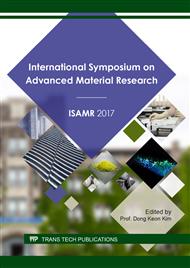[1]
J. Bates, High Temperature Thermal Conductivity of Round Robin Uranium Dioxide, US Atomic Energy Commission, (1970).
DOI: 10.2172/4084378
Google Scholar
[2]
K. Remschnig, T. Le Bihan, H. Noel, P. Rogl, Structural chemistry and magnetic behavior of binary uranium silicides, Solid State Chem. 97 (1992) 391.
DOI: 10.1016/0022-4596(92)90048-z
Google Scholar
[3]
G. Kimmel, B. Sharon, M. Rosen, Structure and phase stability of uranium--silicon U3Si at low temperatures, Acta Crystallogr B, 36 (1989) 2386.
Google Scholar
[4]
P. Villars, L. D. Calvert, PearsonÕs Handbook of Crystallographic Data for Intermetallic Phases, ASM, MaterialsPark, OH, (1991).
Google Scholar
[5]
S. F. Pugh, Swelling in alpha uranium due to irradiation, J. Nucl. Mater. 4 (1961) 177-199.
Google Scholar
[6]
B. T. Massalski, Binary Alloy Phase Diagrams, Materials Park, (1990) 1485.
Google Scholar
[7]
C. Jegou, S. Peuget, J. F. Lucchini, C. Corbel, Identification of the mechanism limiting the alteration of clad spent fuel segments in aerated carbonated groundwater, J. Nucl. Mater. J. Nucl. Mater. 362 (2004) 144-156.
DOI: 10.1016/j.jnucmat.2004.01.008
Google Scholar
[8]
D. Vanderbilt, Soft self-consistent pseudopotentials in a generalized eigenvalue formalism, Phys. Rev. B, 41 (1990) 7892–7895.
DOI: 10.1103/physrevb.41.7892
Google Scholar
[9]
M. D. Segall, J. D. L. Philip, M. J. Probert, C. J. First-principles simulation: ideas, illustrations and the CASTEP code, J. Phys.: Condens, Matter 14 (2002) 2717.
DOI: 10.1088/0953-8984/14/11/301
Google Scholar
[10]
J. P. Perdew, K. Burke, M. Ernzerhof, Generalized gradient approximation made simple, Phys. Rev. Lett. 77 (1996) 3865–3868.
DOI: 10.1103/physrevlett.77.3865
Google Scholar
[11]
T. H. Fischer and J. Almlof, General methods for geometry and wave function optimization, J. Phys. Chem. 96 (1992) 9768.
DOI: 10.1021/j100203a036
Google Scholar
[12]
M. Freyss, First-principles study of uranium carbide: Accommodation of point defects and of helium, xenon, and oxygen impurities, Phys. Rev. B, 81 (2010) 014101.
DOI: 10.1103/physrevb.81.014101
Google Scholar
[13]
H. J. Monkhorst, J. D. Pack, Special points for Brillouin-zone integrations, Phys. Rev. B, 13 (1976) 5188–5192.
DOI: 10.1103/physrevb.13.5188
Google Scholar
[14]
J. Yang, J. P. Long, L. J. Yang, D. M. Li, First-principles investigations of the physical properties of binary uranium silicide alloys, J. Nucl. Mater. 443 (2013) 195.
DOI: 10.1016/j.jnucmat.2013.07.022
Google Scholar
[15]
M. J. Mehl, B. M. Klein, and D. A. Papaconstantopoulos, in Intermetallic Compounds: Principles and Practice. Westbrook and R. L. Fleischer, (1965).
Google Scholar
[16]
M. Jafari, N. Zarifi, M. Nobakhti, A. Jahandoost, Pseudopotential calculation of the bulk modulus and phonon dispersion of the bcc and hcp structures of titanium, Phys. Scr. 83 (2011) 065603.
DOI: 10.1088/0031-8949/83/06/065603
Google Scholar
[17]
M. Rosen, Y. Gefen, G. Kimmel, A. Halwany, Transformation twins and the elastic properties of U3Si at low temperatures Phil. Mag. 28 (1973) 1007.
DOI: 10.1080/14786437308220964
Google Scholar
[18]
P. L. Blum, G. Silvestre, H. Vaugoyeau, On the binary system uranium-uranium dioxide, Compt. Rend. Acad. Sci. 260 (1965) 5538.
Google Scholar
[19]
P. A. G. O'Hare et al. Thermodynamics of Nuclear Materials, IAEA, 2 (1975) 439–453.
Google Scholar
[20]
P. Gross, C. Hayman, H. Clayton, Thermodynamics of Nuclear Materials, IAEA, (1962) 653–665.
Google Scholar
[21]
T. Petit, C. Lemaignan, F. Jollet, B Bigot, Point defects in uranium dioxide Phil. Mag. B, 77(1998) 779.
DOI: 10.1080/13642819808214834
Google Scholar
[22]
H. Vaugoyeau, L. Lombard, J. Morlevat, Contribution to the study of the equilibrium diagram uranium silicon, J. Nucl. Mater. 39 (1971) 323–329.
DOI: 10.1016/0022-3115(71)90153-x
Google Scholar
[23]
M. Freyss, Point defects in uranium dioxide: Ab initio pseudopotential approach in the generalized gradient approximation, J. Nucl. Mater. 347(2005) 44-51.
DOI: 10.1016/j.jnucmat.2005.07.003
Google Scholar
[24]
T. Wang, N. Qiu, X. Wen,Y. First-principles investigations on the electronic structures of U3Si2, J. Nucl. Mater. 469 (2016) 194.
Google Scholar
[25]
E. Bevillon, R. Ducher, M. Barrachin and Roland Dubourg, First-principles study of the stability of fission products in uranium monocarbide, J. Nucl. Mater. 426 (2012) 189.
DOI: 10.1016/j.jnucmat.2012.03.014
Google Scholar
[26]
G. Brillant, A. Pasturel, Study of Ba and Zr stability in UO2±x by density functional calculations, Phys. Rev. B, 77 (2008) 184110.
Google Scholar
[27]
F. Gupta, G. Brillant, A. Pasturel, Correlation effects and energetics of point defects in uranium dioxide: a first principle investigation, Philos. Mag. 87 (2007) 2561.
DOI: 10.1080/14786430701235814
Google Scholar
[28]
M. R. Finlay, Irradiation behaviour of uranium silicide compounds, J. Nucl. Mater. 325 (2004) 118–128.
Google Scholar


